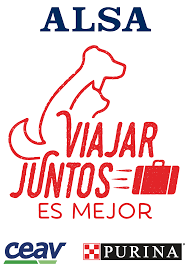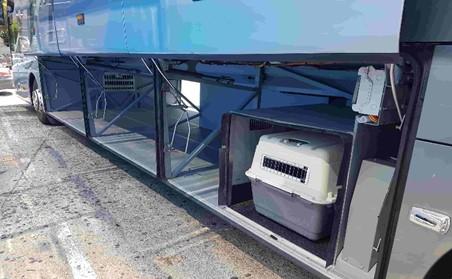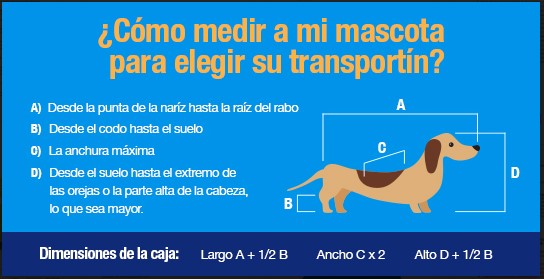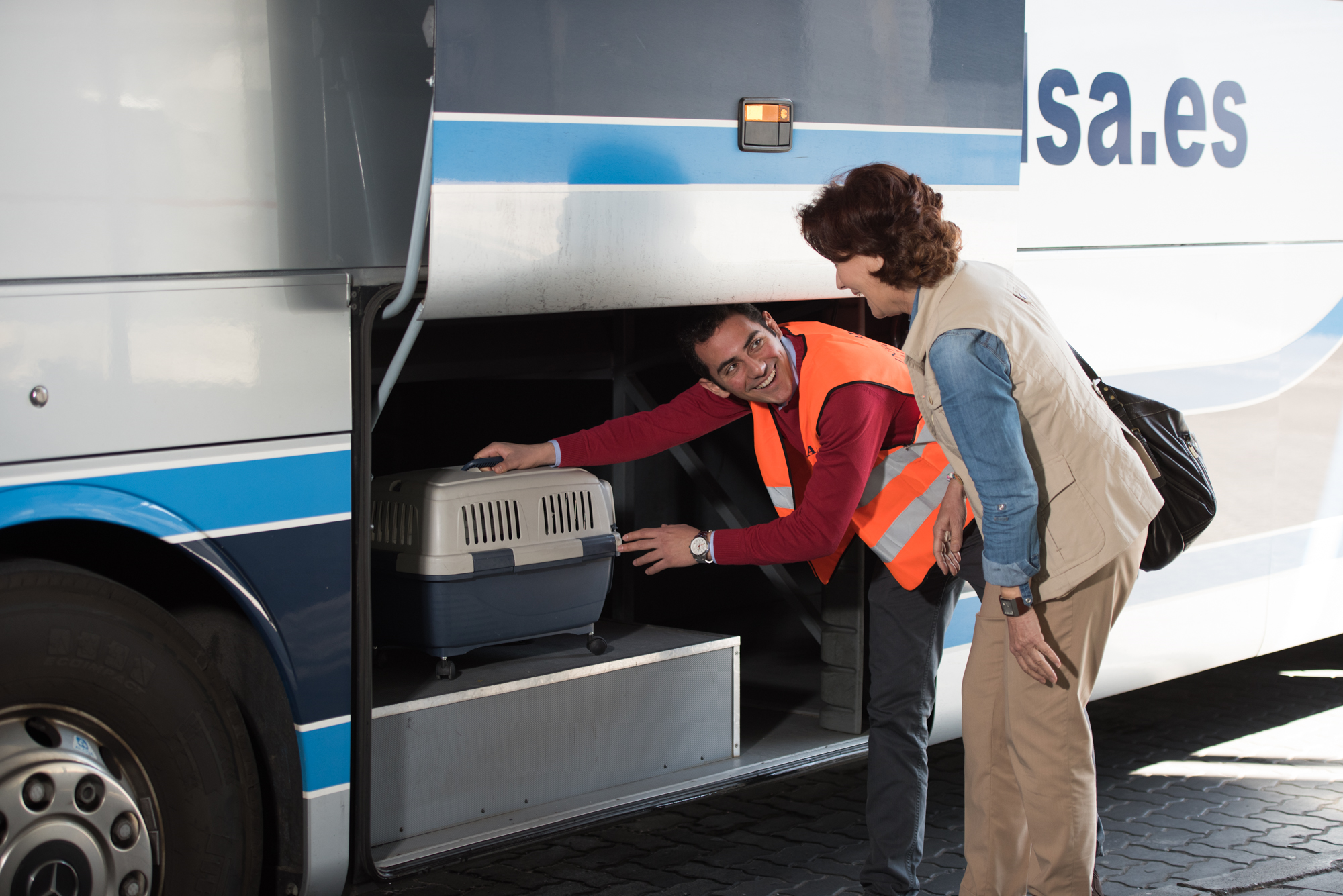Article 11 of the General Traffic Rules does not allow pets to travel with people in buses, except for guide dogs, who will always be under the responsibility of their owners and accompanied by them.

Alsa's recent inclusion of the programme “Juntos es Mejor” (“Travelling Together is is Better”), created by Purina España and the Spanish Confederation of Travel Agencies (CEAV), with the collaboration of the Ministry of Agriculture, Fishing and Food (MAPA), provides us with advice from vets and professional experts from Purina and the MAPA for collaborating and promoting better travelling conditions for pets in our vehicles, and making public transport by road more available to them so that you can travel with your pet in the bus comfortably and safely.
Add the ticket for your pet by ticking the box provided in step 2 of the purchase process with a 50% supplement* on the ticket price.
* Guide dogs are not subject to the content of this instruction and can travel at no extra cost inside the passenger compartment (sitting in the central aisle) and with proper documentation, accompanied by the blind person or owner of the animal (Article 11 - Traffic Rules).
Conditions and dimensions of the special pet compartments in the bus
- Maximum of one (1) pet is permitted per service, limited to small domestic pets such as dogs, cats, ferrets, birds (not farmyard birds), etc. not over 10 kg in weight.
- Only in exceptional situations, and with the permission of the Service Technician, the driver may allow other non-dangerous pets in the same conditions, the cost of which will be the same as for transporting any other animal.
Regular service buses
- In our Regular, service buses, pets will travel in the hold of the vehicle, in a carrier or other type of safe, closed crate supplied by the traveller, with a leak-proof cage to retain droppings.
Supra buses
Our Supra class buses have a independent luggage compartment adapted with ventilation.*
*Recommended in Supra class buses for travelling with pets at times when the ambient temperature is not too high.

Compartment in Supra bus
Steps to follow before travelling
Travel requirements
You are responsible for your pet, which is why, for your pet to be able to travel safely and comfortably, we would like to remind you of the requirements that need to be met during the trip:
These obligations are there to guarantee the protection and comfort of your pet during transportation.
- Animals must be over 12 weeks of age.
- They must be electronically identified with a microchip.
- They must be accompanied by the necessary documentation identifying the animal and up-to-date with all regulatory vaccinations for the region of origin and destination (health card or passport, updated and in force).
- They must be dewormed internally and externally.
- The animals must be completely healthy, with no injuries and able to move unaided.
- Pregnant females are not allowed to travel, nor any that have given birth within one week.
- You must bring a rigid carrier that cannot be opened from the inside, suitable for the size of your pet and and smaller in size than the space in the bus that we will indicate depending on the category of bus in which you are going to travel.
Recommendations before travelling
- Get puppies and kittens accustomed to transportation conditions during the socialisation period.
- Pay a visit to the vet during the week prior to travelling to make sure the animal is in good health.
- Wash the animal the day before, to avoid bad smells.
- Don’t feed animals during the 6 hours prior to departure.
- Encourage the animal to do its business, and take it for a walk 30 minutes before departure time.
- Leave a toy inside the carrier that can’t be swallowed.
- Provide a drinking bowl and water for the journey.
- Have contact details of a vet at your destination.
- Make sure you have the “luggage” necessary for the animal: food, food bowl and drinking bowl, medication, toys, lead, halter, comb, poo-bags and items for your pet to sleep.
- Have the animal wear an identification plate with a contact telephone number to make it easier to locate in the event of getting lost.
- Make sure the animal is going to be accepted in its destination accommodation and that your activities at your destination will allow you to care for your pet..
We have been given advice from the veterinary team of the Ministry of Agriculture, Fishing and Food (MAPA) and Purina. Those recommendations may be altered in accordance with the documents approved in the Plan of Action for Responsible Pet Ownership (PATRAC).
Great! With these steps, your pet is all ready to travel. But as you know, it has to travel in an approved carrier that is safe for your pet.
How to know what is the right size carrier for your pet?
The size of the carrier has to be suitable for the size of your pet, complying with the following approximate dimensions.

summary, the dimensions of the carrier will be:
- Length: the length of the animal measured from the tip of the nose to the base of the tail + 15 cm approximately.
- Width: 2.5 times the width of the animal approximately.
- Height: height of the animal measured from the ground up to the top of the head + 15 cm approximately.
Check that:
- Pets will travel in carriers or crates appropriate to their size and secured so that they will not slide around with the movement of the vehicle.
- Carriers or crates must be made of non-toxic, non-disposable materials, easy to clean and disinfect. One complete side of the carrier will consist of the door, and will be made in such a way that it cannot accidentally open, neither from the outside nor from the inside.
- The carrier must have an absorbent pad so that excrements do not leak out.
- Provide water every 8 hours at the most.
Day of travel
Come to the boarding point with your pet, at least 15 minutes early, and personally introduce it into the crate and place it in the bus, following the driver’s instructions.

The animal will also be taken off the bus by its owner, if possible without other people close by in order to prevent any awkward or dangerous circumstances that could affect other passengers.
The compartments will be cleaned and disinfected once the animal has disembarked.
Conditions for transporting pets with ALSA follow and comply with the requirements under domestic and European regulations.
 Español
Español
 Català
Català
 Français
Français
 Galego
Galego
 Italiano
Italiano
 Portugues
Portugues
 Euskara
Euskara
 Deutsch
Deutsch






